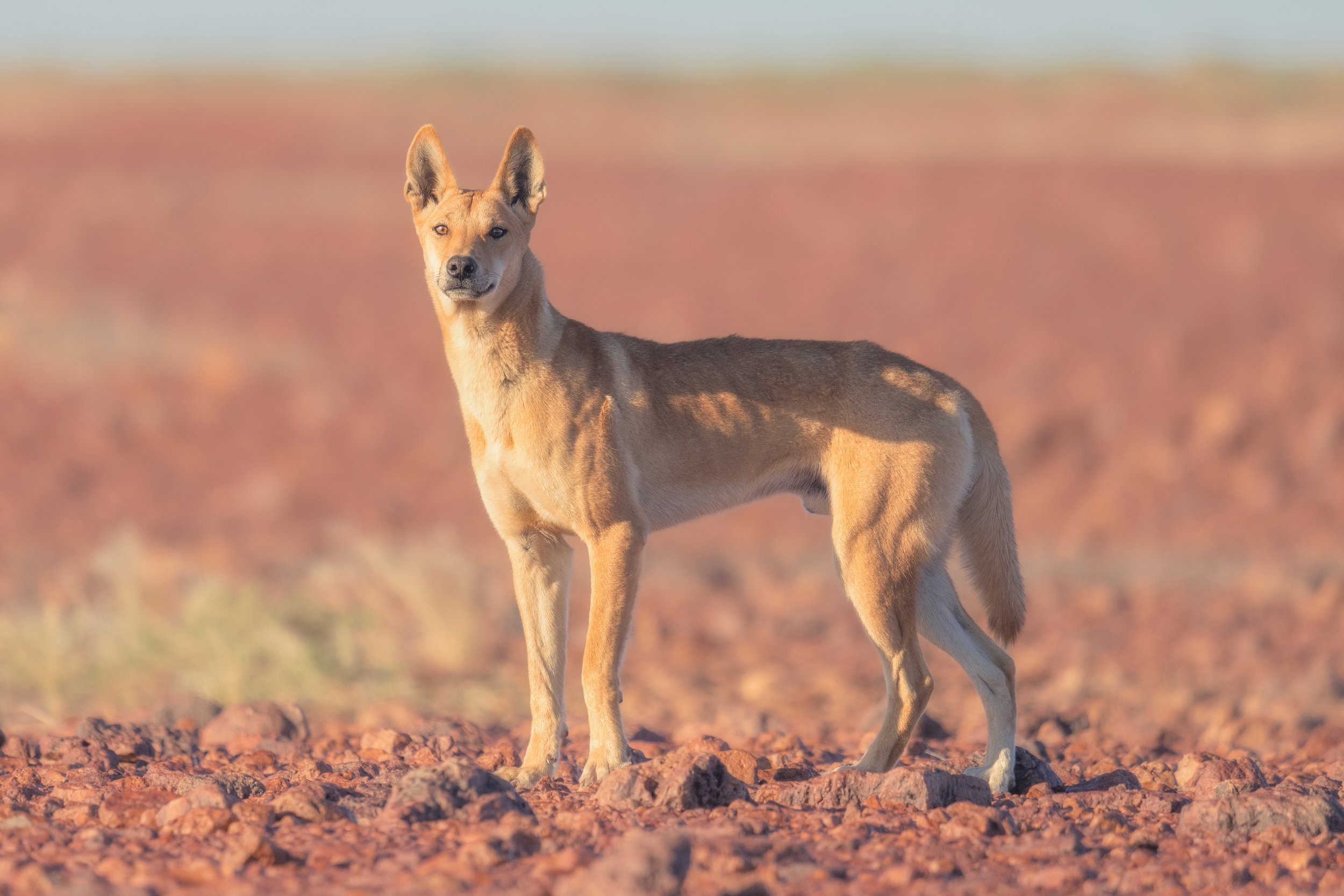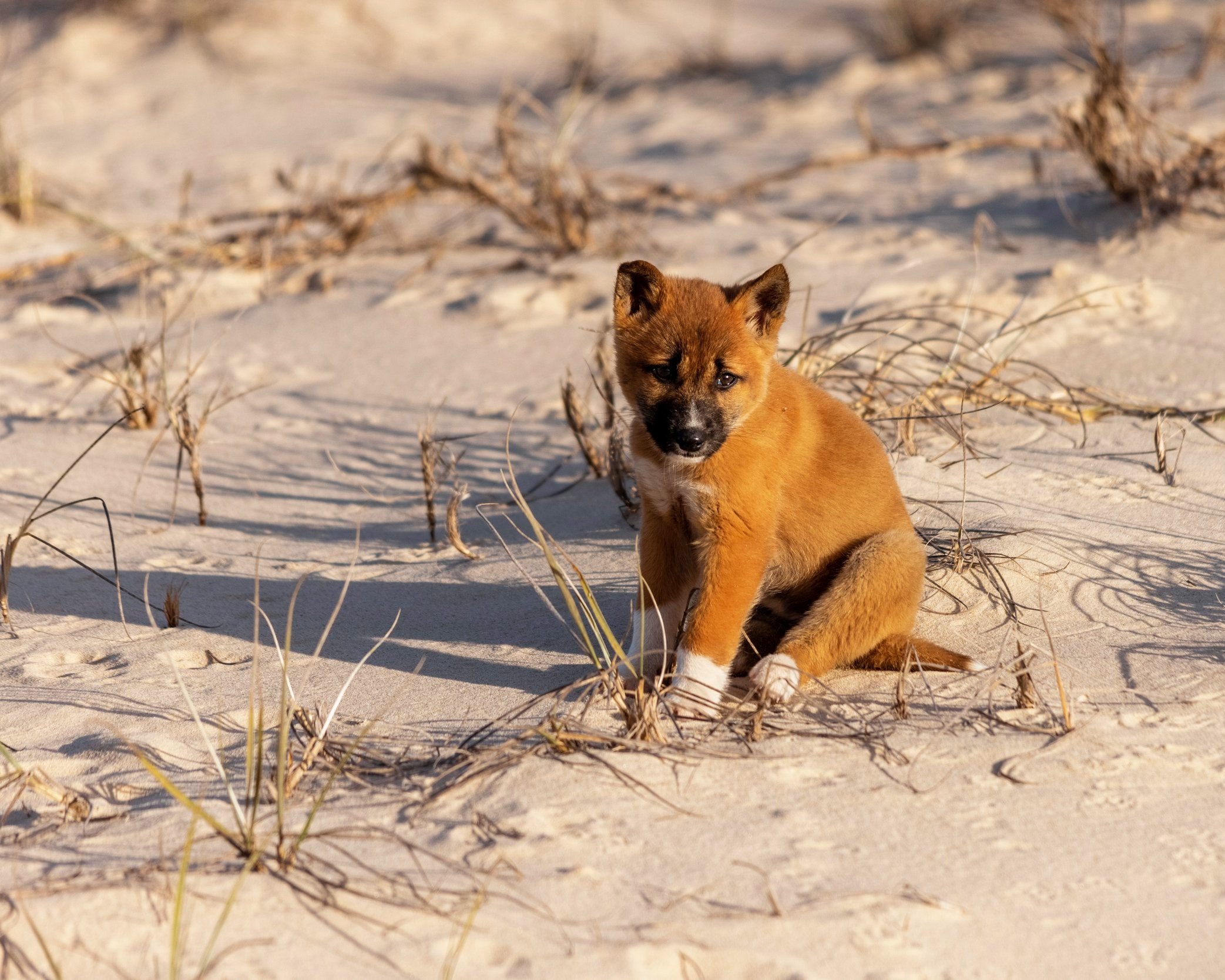
Understanding
Australia’s Iconic Dingo
A vital keystone species
Dingoes are Australia’s only native canid. They are an apex predator and play a very important role in the natural environment keeping natural systems in balance. Dingoes are also identified as a keystone species, which means their unimpacted presence in the environment is essential for healthy ecosystem function.

Why are apex predators important in the environment?
Globally, apex predators are crucial for maintaining balanced and healthy ecological function. In the context of Australia, dingoes do this by limiting herbivores, such as kangaroos and wallabies, and also by competition with, and direct predation of, introduced foxes and feral cats.
Without apex predators food web pathways become unstable, and prey species quickly become over abundant. Increased abundance of prey herbivores results in increased consumption of plants. This not only impacts native plant communities, but also results in a reduction of available habitat and food for small and medium sized animals in the environment.
Dingo habitat and breeding patterns
Dingoes can be found in every mainland state and territory of Australia. They exist in all Australian habitats including woodlands, mountains, grasslands, rainforest, and desert. Dingoes are opportunistic hunters and also occasionally scavenge for food. Their diet is mostly made up of meat, including kangaroos, wallabies, wild pigs, wombats, rabbits, rodents, birds, cats, foxes and lizards.
A recent study analysed dingo diets across the continent and found kangaroos and wallabies are their preferred prey. Depending on the time of year, habitat and size of their prey, dingoes either hunt alone or in cooperation in packs.
Dingoes live in family groups, which usually comprise of 3-12 individuals.
Packs are made up of an adult breeding pair, their pups and young dingoes from previous litters who have not left the family. The breeding pair are the only ones in the pack allowed to reproduce. This family structure is vitally important, because it allows dingoes to pass on their culture to their young.
The breeding pair only reproduce once a year, in winter, which distinguishes them from domestic dogs who can breed twice a year.
The breeding pair and other mature family members work together to raise the young and defend their family’s territory from dangers such as domestic dogs or intruding dingoes. This important system helps to keep pack numbers stable and prevents hybrid breeding (breeding of dingoes with domesticated dogs). In populations with stable pack structures, dingoes (like wolves and coyotes) maintain distinct territories and self-regulate through pack hierarchy and defence.
Heightened dingo activity throughout the year
Dingoes breed between March and June. During this time, males leave their packs in search of a mate. Dingo activity is also markedly increased between December and February as pups leave the den and are large enough to participate in hunting, play and other behaviours.
These periods of heightened activity can lead to increased sightings and interactions. If you live in an area where dingoes are present, being aware of dingo behaviour and safety is recommended.

Dingo pups
belong in the wild
Between July and September is when dingo pups are born and begin emerging from their den. During this time pups are sometimes left unsupervised while other members of their family find food to sustain them. If you see pups without older dingoes around them in the wild, it is important to leave them in their natural habitat. Their parents and other family members aren’t far away.
A culturally
significant animal
Dingoes are culturally significant for many Indigenous peoples across Australia. They are a regular feature of Indigenous culture and Dreamtime stories. For those who the dingo is their totem, the dingo is considered family.
Many First Nations people built strong relationships with dingoes over thousands of years, becoming a ‘cultural keystone species’. Colonisation has had a profound impact on this relationship, and continues to through dingo killing programs that are standard practice due to agricultural systems.
According to advocacy group Dingo Culture, which aims to represent the Aboriginal voice for the dingo, ‘Aboriginal people have strong belief systems that value nature. The dingo is not only a cultural keystone species, but it is also kin (family).’

Keeping feral animal numbers down, helping our environment to thrive
Dingoes have been found to reduce the presence of numerous non-native species in the Australian environment. These include foxes, cats, rabbits, pigs, goats and even deer. This important function in the ecosystem helps to ensure other native animals have the opportunity to thrive.
In areas of significant lethal control targeting dingoes, invasive animal populations tend to be higher without dingoes present to suppress their populations. This can have devastating impacts on small and medium mammals.
Australia has the worst mammalian extinction rate in the world, and the presence of non-native species in the environment is a key threat facing native wildlife. In this way dingoes are an incredible ally in the current biodiversity crisis.
How do dingoes differ
from domestic dogs?
When comparing dingoes with domestic dogs, there are significant differences between the two. Dingoes have longer snouts and wider heads compared to domestic dogs. They are extremely flexible, possessing the ability to rotate their wrists and subluxate their hips. Dingoes are also double jointed in their limbs and can turn their neck 180 degrees in any direction, all of which is impossible for a domestic dog.
Dingoes' jaws can open wider than domestic dogs, their teeth tend to be larger and are evenly spread in their mouth, with slight gaps between each tooth. Despite their larger teeth, dingoes do not experience dental overcrowding like domestic dogs.
The colours of the dingo
It comes as a surprise to many people that dingoes come in a variety of colours and there is no colour that distinguishes a native dingo. While the sandy variety is the most commonly known and photographed, dingo coats can be black, white, tan, brindle, and even patchy.
Research by The University of New South Wales (UNSW) and collaborators found that while 53% of dingoes have a sandy coat colour, 14% were brindle, 11% black and tan, 9% sable, 6% patchy, 5% black, and 1% were white.
Image: Michelle J Photography

Impacts of lethal control on dingoes role in
the environment
Longstanding lethal control measures have had a devastating impact on the ability of dingoes to function in the natural environment, as it breaks down their important family structure. Breaking down pack structures through lethal control sends dingo families into chaos, especially when breeding pairs are killed.
Dingo families impacted by lethal control are less capable of maintaining their territorial integrity, increasing the risk of hybridisation (breeding with outsiders and domestic dogs). It also leads to a higher risk of predation on domestic animals (like livestock) as less experienced dingoes are more likely to target easier prey (like sheep) without guidance from the breeding pair.
If we take care of dingoes, dingoes will take care of us
Dingoes are a keystone species, meaning without them entire ecosystems are at risk of functional collapse. Healthy ecosystems are vital to human survival, and this relies on the complex interactions between animals and plants in the environment. If we care for our native dingoes, they will help to ensure a healthier, more balanced natural environment.










